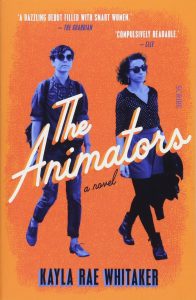Review of Kayla Rae Whitaker. The Animators. London: Random House Trade, 2017.

Animation often draws on literature. Disney had his fairy tales and every good anime starts life as a manga. Inspiration travels in the other direction far less often. Films can bring books to life quite easily it seems, but for a book to speak meaningfully about a visual medium is a difficult thing. And this is why Kayla Rae Whitaker’s first novel, The Animators, is such an interesting piece of writing. In it, she tells the tale of two university friends who go on to become rock star, adult-oriented animators, suffering greatly for their art along the way.
Whitaker introduces the titular animators’ styles through a collage of references, which in some cases are stated, while in others only implied. Their work is a mix of Ralph Bakshi grime and Joanna Quin cheekiness, we are told, with the retro sleaze of Heavy Metal (1981) thrown in. Their relationship echoes that of Matt Stone and Trey Parker. Genndy Tartakovsky, Looney Tunes and 1974’s Dirty Duck all get honorable mentions.
Once Whitaker has established our expectations, she moves into the meat of the narrative. The story begins with the release of their first feature, Nashville Combat, a confessional piece about the wild half of the pair, Mel, and her crack-addicted sex worker mother. It then builds to the release of their second feature, which is to be about the introverted Sharon.
By making her protagonists confessional filmmakers, Whitaker can employ the many tried-and-tested techniques of the novelist. There are dramatic moments, accidents, misunderstandings, fights and loss to keep you reading. What drives the novel, after all, is character – not the mechanics of animation workflows.
These technical aspects are present, however, and despite some minor factual inaccuracies Whitaker does an excellent job of conveying the process of animated storytelling. She shows how a film about one thing soon ends up being about something else. The drawings can start telling the story for you, or else contradict your well-planned emotional beats entirely.
What Whitaker is really writing about is inspiration. In particular, it deals with how inspiration is not a bolt from the blue, and it is not limited to the first moments of a project. Inspiration has started long before any project. It grows in childhood, collects things everywhere along the way, and never stop imposing itself, even after the final edit.
The interesting part of this novel for animators are the myths that the novel draws on for its characterization. Animators aren’t often depicted in media, they don’t even appear in animation that often, so it is interesting to see how a curious non-animator depicts them.
Like most characters written by young novelists, Mel and Sharon smoke like chimneys and drink like fishes. It is hard to envisage this alongside the relentless workload required for animation. The pair also seem to animate their features entirely by themselves.
These elements might seem unrealistic, until we realize that they exist in the mythical mode. Just as a literary genius is depicted in a movie by gasping and setting his quill to paper, the words flowing effortlessly in the order in which they appear in print; so here the novelist’s art shows us the animator’s struggle in the form of an emotionally overflowing two-person studio. The heroism of the animator is inflated. Just two against the whole world.
The Animators may not leave its readers more knowledgeable about animation, but it might just create the types of myth-work that will draw wider audiences to our beloved medium. As it has just been taken on by Penguin Random House for worldwide distribution I believe this to be a reasonable hope. I highly recommend it.
Joseph Darlington is Programme Leader for BA(Hons) Digital Animation with Illustration at Futureworks Media School. He holds a PhD in experimental aesthetics and has published widely on technology and culture. He recently guest edited a special edition of the journal Information, Communication and Society on the theme of “Work and Play”.
